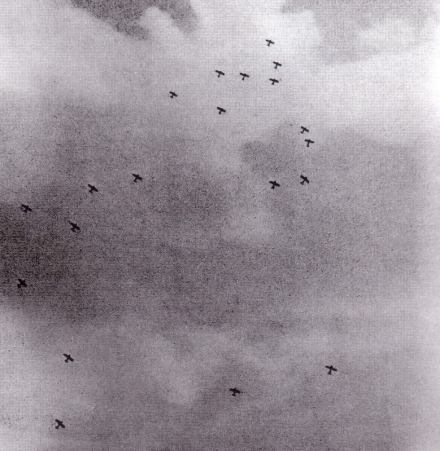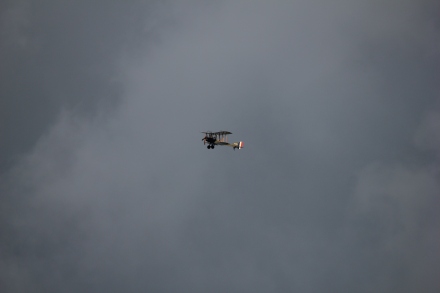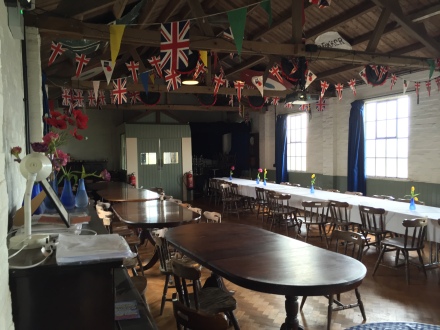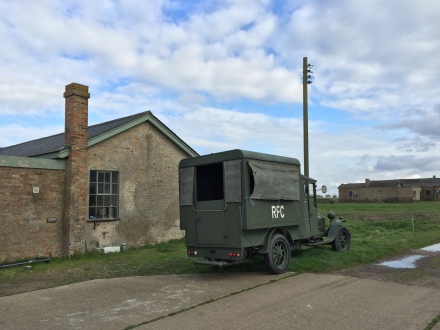Word has come in from the outposts of S&G territory – in this case, Essex – of some wonderful goings-on. In this instance it is the restoration of a First World War Airfield to full working order at Stow Maries.
This little patch of farmland, located between the seaside town of Malden and the county town of Chelmsford, is home to some buildings that were erected a century ago for a very particular purpose. These fields were once a hive of activity during the defence of London in the First World War, after marauding Zeppelins became a regular menace during 1915 and the massed daylight bombing raids of Gotha aircraft swept Britain into a state of hysteria.

The attacking Gotha bombers photographed over London
In September 1916, the hastily-built airfield at Stow Maries received the Royal Aircraft Factory B.E.2s of ‘B’ Flight of 37 (Home Defence) Squadron. The favoured route for German raiders was to make landfall on the Essex coast and then cruise down towards Epping Forest in the knowledge that within minutes their bombs would fall near something valuable.
The first commanding officer at the aerodrome was Lieutenant Claude Ridley, who was only 19 years of age. On the evening of 23/24 May 1917 Ridley, promoted to Captain, and Lieutenant G. Keddie made the first recorded operational flight from the aerodrome in response to a large Zeppelin raid targeting London.
Air defence was in its infancy and for every Zeppelin brought down in a sea of falling flame there were hundreds of hours spent by pilots tootling around in the dark. Often they had to light flares on the end of their wings to see the runway on final approach. It was dark and dangerous work but ultimately something of a footnote in the history of the conflict.

Alone in the great big sky: the solitary life of Home Defence flying re-created
Not that this precluded the growth of Stow Maries, which soon saw ‘A’ Flight of 37 Squadron arrive alongside the rest of the unit. It was a busy time for London and, during the early hours of 17 June 1917, 2nd Lieutenant L. P. Watkins was credited with the downing of Zeppelin L48 at Theberton in Suffolk – the last Zeppelin brought down on British soil before the arrival of the fixed-wing Gotha bombers.
It was these massed daylight raids that caused pandemonium in the capital, and 37 Squadron was in the thick of the action on 7 July 1917 when 22 Gotha bombers made one of the heaviest raids on London. The combination of unreliable engines, numerous landing accidents and increasingly effective Home Defence – not only from the aircraft of the Royal Flying Corps and Royal Naval Air Service but also the anti-aircraft batteries ringing London – took a heavy toll on the daylight raiders. Soon they were compelled to fly at night and in smaller groups.
At its peak, Stow Maries was home to 219 staff and 16 aircraft – centred around all three flights of 37 (Home Defence) Squadron, ‘A’, ‘B’ and ‘C’. It’s original B.E.2 aircraft were replaced first with the B.E.12 and, much later, with the Sopwith Camel.

Both inside and out, Stow Maries is returning to former glories
Unlike other Home Defence stations which were further developed and would win fame in the later Battle of Britain in 1940 – Biggin Hill, Manston and Hornchurch in particular – Stow Maries reverted to peacetime farming soon after the Armistice of 1918. After 37 Squafton’s departure in March 1919, its buildings were abandoned and forgotten about until a group of enthusiasts happened upon them and discovered what amounted to the only preserved World War 1 airfield in existence.
In the space of four years between 2007 and 2011, six of these buildings were fully conserved and one partially conserved. The decades of neglect were brushed aside and the structures were restored with appropriate materials in accordance with their original construction and architectural detailing.
Now, after venturing down a rather rustic farm track, it is possible to walk into the world of 1917 where the volunteers have now restored the Ambulance Shed and Mortuary, the Blacksmith’s Shed, the Workshop and Dope Shop and the NCO Mess. The Squadron Offices have now been rebuilt and house the museum, while the Workshop and Dope Shop have been conserved to comply with modern workshop environment conditions, but behind the modern internal wall finish is the original fabric untouched.

Fixtures, fittings and the occasional bit of hardware can now be seen by visitors
Work is indeed undertaken on aircraft at Stow Maries – aircraft of 1914-18 vintage. In the only modern construction to be found at the site you will find hangared an assortment of tool-room copies of WW1 aircraft built by Sir Peter Jackson’s brilliant operation in New Zealand, The Vintage Aviator Ltd.
Recently, Stow Maries hosted its first fly-in for these magnificent aircraft, from where these photos have been provided. Complete with a supporting cast of re-enactors buzzing around the partially-restored Pilots’ Ready Room (the S&G collectively remains a little unsure about the value of re-enactors), the sights and sounds of aviation were laid out for the assembled hordes.
The Bristol Scout, Albatros D.V, and Sopwith Snipe encapsulated the progress made in aircraft design in 1916-18, while the B.E.2 was utterly at home on the field from which 37 Squadron campaigned the type so vigorously against the bombers. It is an amazing sight to see the facilities and the machines in an environment all-but unchanged in a century, and long may the good folk who have brought Stow Maries back to life continue to offer the world such a unique insight into the war.
There is still much work to be done, the roll-call of buildings requiring or undergoing conservation includes:
- Office and Communications Room
- Motor Transport Shed
- Royal Engineers’ Workshop
- Generator Hut
- Reception/Headquarters Building
If there is the will, the energy and the funding available, a further 14 buildings may yet also be saved to complete the restoration, these being:
- Officers’ Mess
- Officers’ Quarters (four buildings)
- Men’s Accommodation Block
- NCO Accommodation
- WRAF Accommodation (three buildings)
- Water Tower and Reservoir (two buildings)
- Fuel Store
- Ammunition Store
To find out more about the airfield, the aircraft, when and how to visit and for news on forthcoming events please visit the website of this remarkable undertaking.

